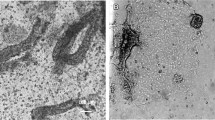Abstract
Research on mastitis in dairy cows caused by Escherichia coli has reported the emergence of strains capable of inducing chronic mastitis and that these strains adhered to and internalized into bovine mammary epithelial cells better than strains of E. coli isolated from acute mastitis. To understand mechanisms and strategies used by chronic E. coli strains to survive intracellularly internalization studies using bovine mammary epithelial cells treated with inhibitors of caveolae-mediated endocytosis (CME) and receptor-mediated endocytosis (RME), double immunofluorescence labeling confocal laser and fluorescence microscopy were conducted. Internalization studies showed that strains chronic E. coli strains persisted intracellularly longer than acute E. coli strains. Treatment of bovine mammary epithelial cells CME or RME inhibitors resulted in lower numbers of intracellular E. coli strains associated with chronic or acute mastitis than untreated controls. In addition, when selective CME inhibitors were used significantly fewer chronic E. coli were detected intracellularly than acute E. coli or untreated controls. Confocal laser microscopy showed that chronic E. coli strains colocalized preferentially with caveolae whereas acute strains did so with early endosomes, an early step of RME. These results suggest that strains of E. coli associated with chronic mastitis exploit lipid rafts/CME to internalize into and move through mammary epithelial cells. By exploiting this endocytosis pathway, chronic E. coli strains avoid bactericidal mechanisms such as endosome acidification and endosome-lysosome fusion, thus allowing intracellular survival. Data from this study helps to explain how these strains are capable of causing chronic E. coli mastitis.






Similar content being viewed by others
References
Almeida RA, Oliver SP (1995) Invasion of bovine mammary epithelial cells by Streptococcus dysgalactiae. J Dairy Sci 78:1310–1317
Almeida RA, Oliver SP (2006) Trafficking of Streptococcus uberis in bovine mammary epithelial cells. Microb Pathog 41:80–89
Almeida RA, Matthews KR, Cifrian E, Guidry AJ, Oliver SP (1996) Staphylococcus aureus invasion of bovine mammary epithelial cells. J Dairy Sci 79:121–126
Anderson RG (1988) The caveolae membrane system. Annu Rev Biochem 67:199–225
Barker LP, George KM, Falkow S, Small PLC (1997) Differential trafficking of live and dead Mycobacterium marinum organisms in macrophages. Infect Immun 65:1497–1504
Bradley AJ, Green MJ (2001) Adaptation of Escherichia coli to the bovine mammary gland. J Clin Microbiol 39:1845–1849
Chastellier C, Berche P (1994) Fate of Listeria monocytogenes in murine macrophages: evidence for simultaneous killing and survival of intracellular bacteria. Infect Immun 62:543–553
Chistoforidis S, Miaczynska M, Ashman K, Wilm M, Yip SC, Waterfield MD, Backer JM, Zerial M (1999) Phosphatodylinositol-3-OH kinases are Rab-5 effectors. Nat Cell Biol 1:249–252
Clemens DL, Lee BY, Horwitz MA (2004) Virulent and avirulent strains of Francisella tularensis prevent acidification and maturation of their phagosomes and escape into the cytoplasm in human macrophages. Infect Immun 72:3204–3217
Dogan B, Klaessing S, Rishniw M, Almeida RA, Oliver SP, Simpson K, Schukken YH (2006) Adherent and invasive Escherichia coli are associated with chronic bovine mastitis. Vet Microbiol 116:270–82
Döpfer D, Barkema HW, Lam TJGM, Schukken YH, Gaastra W (1999) Recurrent clinical mastitis caused by Escherichia coli in dairy cows. J Dairy Sci 82:80–85
Döpfer D, Almeida RA, Lam TJGM, Nederbragt H, Oliver SP, Gaastra W (2000) Adhesion and invasion of Escherichia coli from recurrent clinical cases of bovine mastitis. Vet Microbiol 74:331–343
Duncan MJ, Shin JS, Abraham SN (2002) Microbial entry through caveolae: variations on a theme. Cell Microbiol 4:783–791
Huynh HT, Robitaille G, Turner JD (1991) Establishment of bovine mammary epithelial cells (MAC-T): an in vitro model for bovine lactation. Exp Cell Res 197:191–199
Matthews KR, Almeida RA, Oliver SP (1994) Bovine mammary epithelial cell invasion by Streptococcus uberis. Infect Immun 62:5641–5646
Molinari G, Rhode M, Guzman CA, Chhatwal GS (2000) Two distinct pathways for the invasion of Streptococcus pyogenes in non-phagocytic cells. Cell Microbiol 2:145–154
Norkin LC (2001) Caveolae in the uptake and targeting of infectious agents and secreted toxins. Adv Drug Deliv Rev 49:301–315
Oliver SP, Mitchell BA (1984) Prevalence of mastitis pathogens in herds participating in a mastitis control program. J Dairy Sci 67:2436–2440
Passey S, Bradley A, Mellor H (2008) Escherichia coli isolated from bovine mastitis invade mammary cells by a modified endocytic pathway. Vet Microbiol 30:151–164
Pelkemans L, Burli T, Zerial M, Helenius A (2008) Cavelolin-stabilized membranes domains as multifunctional transport and sorting devices in endocytic membrane traffic. Cell 118:767–780
Peyron P, Bordier C, N’Diaye EN, Maridonneau-Parini I (2001) Nonopsonic phagocytosis of Mycobacterium kansasii by human neutrophils depends on cholesterol and is mediated by CR3 associated with glycosylphosphatidylinositol-anchored proteins. J Immunol 165:5186–5191
Shin JS, Gao Z, Abraham SN (2000) Involvement of cellular caveolae in bacterial entry into mast cells. Science 289:785–788
Smith JL, Campos SK, Wandinger-Ness A, Ozburn MA (2008) J Virol 82:9505–9512
Sreenivasan PK, Meyer DH, Fives-Taylor PM (1993) Requirements for invasion of epithelial cells by Actinobacillus actinomycetemcomitans. Infect Immun 61:1239–1245
Stan RV (1988) Structure and function of endothelial caveolae. Microsc Res Tech 57:350–364
Styrt B, Klempner MS (1988) Effects of pH on killing of Staphylococcus aureus and Escherichia coli by constituents of the neutrophil phagolysosome. J Med Microbiol 25:101–107
Acknowledgements
This work was supported by the Indirect Vitamins Purchasers Antitrust Litigation 426 Settlement administered by the New York State Attorney General, and Tennessee AgResearch.
Author information
Authors and Affiliations
Corresponding author
Rights and permissions
About this article
Cite this article
Almeida, R.A., Dogan, B., Klaessing, S. et al. Intracellular fate of strains of Escherichia coli isolated from dairy cows with acute or chronic mastitis. Vet Res Commun 35, 89–101 (2011). https://doi.org/10.1007/s11259-010-9455-5
Accepted:
Published:
Issue Date:
DOI: https://doi.org/10.1007/s11259-010-9455-5




